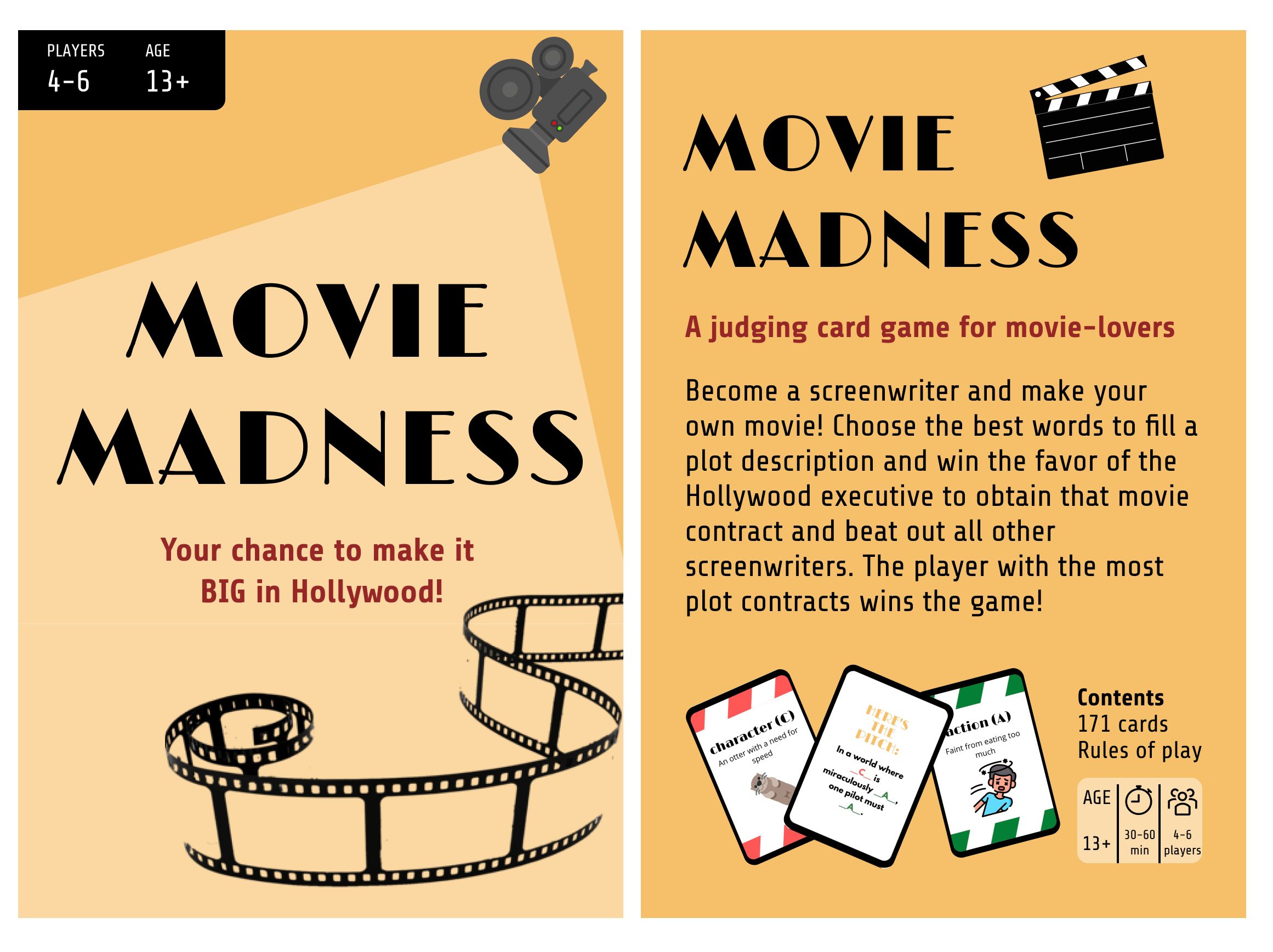Designed and created by: Chu Zhang, Sam Silverstein, Rebecca Jia, Grace Zhou
Artist’s Statement
Our vision for Movie Madness was simple: create a game that allows people to get their storytelling juices flowing, and have fun and bond with friends while doing it. We intended for the game to be one that incorporates humor into the social interaction of playing a game. To accomplish these goals, we created a game where players create movie plots that can turn out to be outrageous, weird, surprising, and funny. We aimed for our character and action cards to be wild and silly, so that the combinations of plots that players came up with using these cards would be entertaining. Not only did we focus on storytelling, but since our objective was also to make a fun and interactive social game, we also tried to incorporate mechanics into our game that let each person’s personality shine through; one mechanic that we incorporated, for example, was the element of judging with the Hollywood Producer (a role that rotates between players from round to round), who decides which player wins each of the rounds. Ultimately, we strived to produce a game that brought people together and encouraged creativity and social bonding.
Concept Sketches and Mind Map
In order to explore the idea space of our game, we each brainstormed and sketched out 5 different game mechanics:
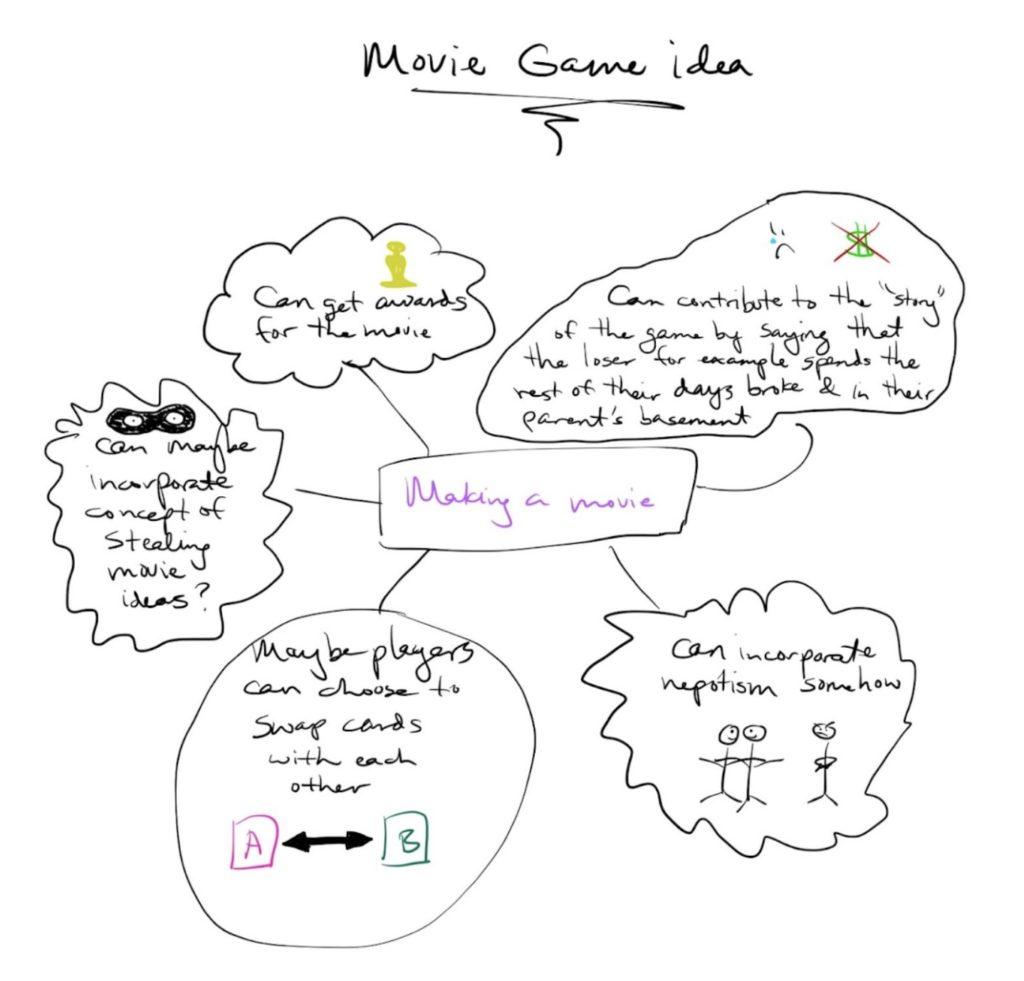
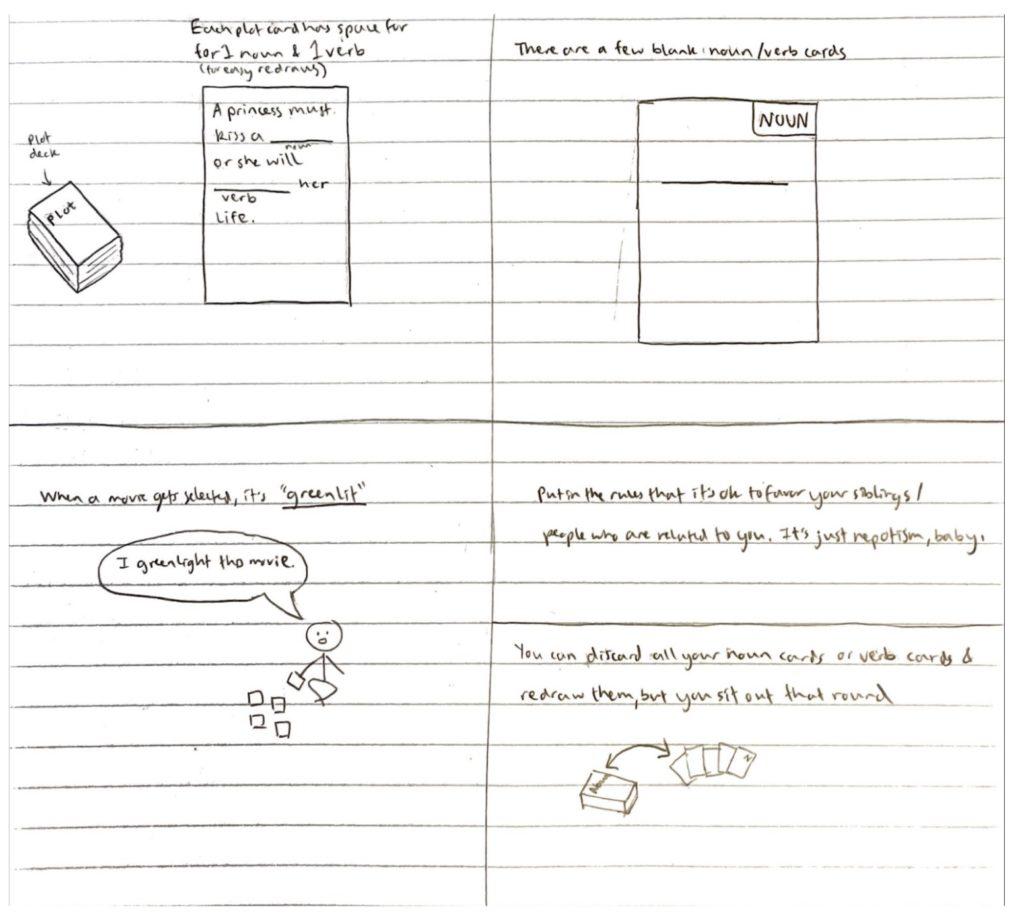

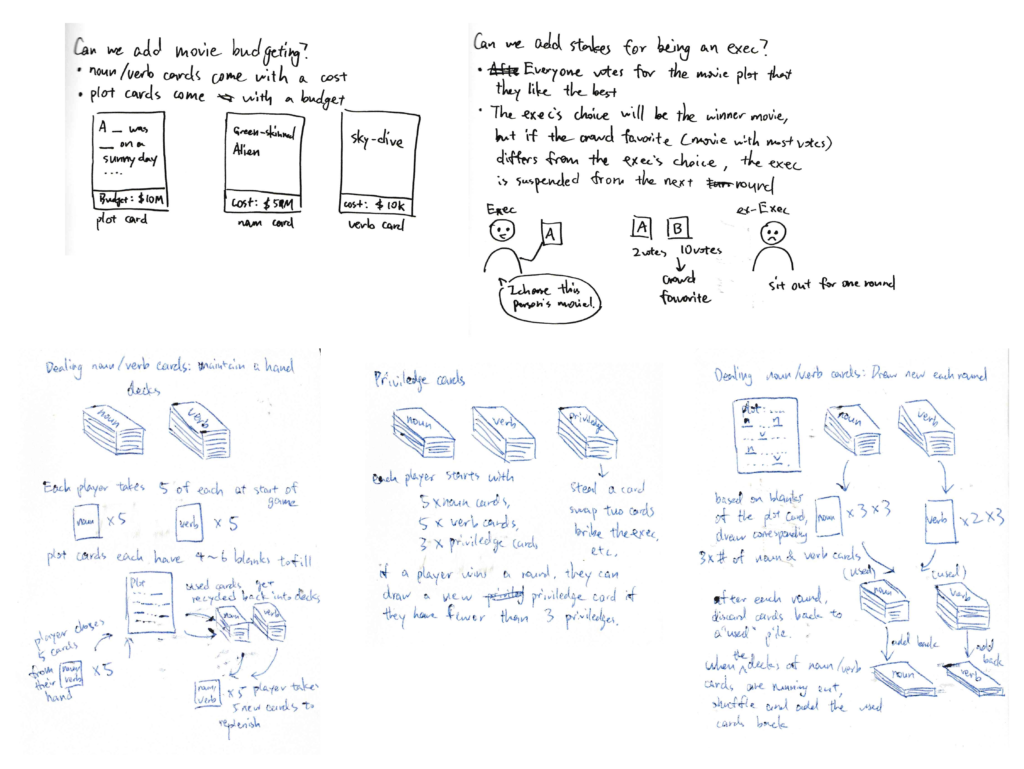
Throughout the project, we solidified our concept and developed game mechanics that support our objectives, as shown in the mind map below:

Initial Decisions for the Game
In the initial concept for Movie Madness, players drew a movie premise (a noun and a verb card), and then each player wrote down a title for it. A judge chose the best title. We decided to modify this so that players instead fill in a movie premise/plot with nouns and verbs in their hand. The types of fun we aimed for with our game were primarily fellowship and expression, and we felt this along with other choices would support that.
The game incorporates multilateral competition: players play against each other to try to win the most plot cards. We chose this category because we wanted players to have fun coming up with interesting plots (expression) and reacting to what others came up with (fellowship). By pitting all players against each other, each person will come up with the best plot they can and more plots can be shared with the group.
For the procedures of this judging game, we took inspiration from Apples to Apples and Cards Against Humanity. Players begin with a set amount of answer cards that they can pick and choose from. As writers ourselves, we are aware of how difficult coming up with creative characters and story actions is. Recognition is easier than recall, so we decided to provide options players can select from rather than make them write answers from scratch. At the beginning of the round, a prompt card with blanks is displayed, and players select which of their cards they feel best fills in the blanks. Since the fill-in-the-blank concept is used in many situations, from tests to medical forms, we knew it would be familiar and easy for players to do. Then, the judge selects which movie plot they want to move forward with. There are no rules to judging – it’s entirely up to the judge what to pick – so the game helps players get to know each other’s preferences, facilitating fellowship.
We decided to make the prompts short fill-in-the-blank movie plots because they allow room for flexibility and creativity. We considered making the plot cards longer, with multiple sentences outlining a story. However, we decided against that because it would require each player to wield a high amount of option cards, and it creates cognitive load for the judge to have to remember and compare longer plots. And while Madlibs asks for multiple parts of speech to fill in the blanks, we decided to only ask players to fill in nouns and verbs because they make the most significant difference in sentence meaning. In the first version of the game, we had players hold 5 verb cards and 5 noun cards in each round. We wanted to give them enough options for them to express themselves and come up with creative answers, but not so much that they struggle to sort through the cards.
The winner is the player who ends up with the most plot cards. We hoped this would create a lighthearted competition among players and incentivize them to come up with interesting, entertaining plots that help instill fellowship among the group. This kind of outcome could also push players to get creative and try to express themselves in different, new ways. However, everyone can gain plot cards and gain a sense of accomplishment from that. At the very least, players can enjoy hearing what others came up with.
One of our values was to keep the game low-stakes so players can have fun and feel good will towards each other. Supplying pre-written answers helps with that – much of the game outcome is the result of luck with what cards you’re dealt. Another one of our values for this game was humor. Laughing at answers together can create social bonds and great memories to look back on. To facilitate humor, we decided that our noun (“character”) and verb (“action”) cards would be silly, wacky, and funny rather than realistic and sensical.
Testing and Iteration History
We went through 3 rounds of playtests in total and iterated our game design based on the observations and feedback from the playtests as well as our section leader. All versions of the cards that we used in the playtests can be found in the appendix.
Playtest and Iteration #1
Playtest Objective
Since this is the initial playtest, we wanted to test how well the fundamental design choices work out. Specifically, we were interested in the questions below:
- Are the number of blanks (3 to 4) on the plot cards enough for players to be creative and come up with funny plots?
- Is the number of cards (4 action cards and 4 character cards) each player maintains per round enough for players to choose from?
- Are the plots long enough to be interesting and engage players? They are currently 3 to 4 sentences long.
Playtest Participants
For our initial playtest, our playtest participants were students from the class that were in other project groups. We had a total of 6 players and we conducted two rounds of playing (two plot cards drawn). During the playtest, we took notes based on our observations and then afterwards, asked for feedback from the participants.
Feedback, Issues, and Responses
One of the main issues we found in this playtest was that one round took too long and as a result, players had a hard time keeping track of everyone’s plots and often lost interest halfway through. We observed that players either needed a long time to read out the plot cards or they would just shorten the plot on their own. The Hollywood Executives often had a hard time remembering all the plots and sometimes only judged based on a subset of the blanks on the plot card. Some players also expressed concern over bias towards the last person to read out their plot, since that plot is in the Hollywood Executive’s most recent memory. We identified the main reason for this is that the plot cards are too long and complex. During the playtest, we did not take immediate action on the issues related to card content, since there is no good way to quickly change them and print new cards. We made changes afterwards for the second playtest as described below:
- Limit the number of recommended players to 4 ~ 6. No matter how short the plots are, when the number of players increases, it is bound to get hard for players to keep track of everyone’s cards. Since our game is aimed to be a party game, we don’t want to burden people with the task of trying to remember too many plots.
- Simplify the plot cards while keeping the character and action cards interesting and detailed. We found that long complex plot cards not only hindered the ability of players to come up with good combinations of character and action cards to fill the blanks, but they also got boring as every player repeated the same sentences while presenting their filled-out plots. By simplifying the plot cards, we increased the ratio of the distinct interesting parts of the plot to the shared, common parts of the plot, making the game more engaging for players.
We also found that the number of cards in a hand was not enough for players to choose the best combination to fill out the blanks. Players complained that they ran out of good cards to choose from quickly. We didn’t change the number of cards in a hand during the playtest because we only had time to play two rounds and we did not want to interrupt the game flow. For the following playtest, we increased the number of cards to 6 character cards and 6 action cards in a hand. Coming up with the best combination of cards to fill in the blanks is a crucial game mechanic that encourages our desired fun types of expression, so we want to make sure players feel that they have enough card choices to express their creativity.
Another issue discovered was that the slashes on the action cards were confusing to one player. To address this issue, we changed all the action cards to be in present simple tense. We believe that players will have enough context to understand that they need to convert the present simple test verbs to the appropriate form based on the plot card. (Note that this change was not made in time for playtest #2, so it is tested in playtest #3).
In addition, at first the players mistakenly tried to let the Hollywood Executive read out all the players’ movie plots, which was not what we intended — each player was supposed to read out and pitch their own plot. When this issue happened, we chose to intervene and correct the procedure since it was an integral part of our rules. After the playtest we updated our rule sheet to clarify the procedure. However, we did consider that perhaps anonymity would help prevent abuse such as favoritism, so we decided to tested out this alternative procedure of the Hollywood Executive reading out all of the cards in the following playtests.
Good moments and Responses
In this initial playtest, we observed a lot of laughter throughout the game, triggered by the hilarious and absurd plots that players came up with. Some players used a movie voice to read out their cards, which gained smiles and praise from other players. The different ways players read out their cards brought a nice personality to the plots and spiced up the game. We realized that when the Hollywood theme was reinforced positive feedback was triggered. For this reason, we decided to revise our plot cards and try to use more movie tropes.
We also observed that players generally preferred continuity. They tended to choose or vote for plots that were filled out with cards that were related in some way. Led by this observation, we decided to revise our character and action cards to create more continuity in them.
Playtest and Iteration # 2
Playtest Objectives
For the second playtest, we recruited four students in the class. We aimed to refine the rules and procedures of the game and specifically answered these questions:
- Should the plot card be hidden from the executive?
- How does the number of blanks to fill in (2 vs. 3) affect enjoyment?
- Should players read their own filled-in plots aloud or give them to the exec?
- Should more movie-related mechanics be added?
- How does having 6 action and 6 character cards in hand affect gameplay and enjoyment?
Feedback, Issues, and Responses
In this playtest, we tested hiding the plot card from the executive in order to see if this would make the game more enjoyable. This led to confusion and went against what players desired. Players struggled to keep the plot card out of the executive’s sight but also view it for themselves. The executives also wanted to know the plot to feel prepared. Since this mechanic was unintuitive and did not improve the game, we decided to keep it out of the final version.
After editing the plot cards to be shorter, some included three blanks for players to fill in. We wanted to see if three rather than two blanks gave players more of the “expression” type of fun. In this playtest, players reported that three blanks felt “too much” and were “harder than matching two.” Because players did not enjoy the three-blank cards and it introduced extra difficulty, we decided to edit the plots to have just two blanks.
We tested once again players reading their own cards out loud. This time, players expressed to us that they would prefer submitting their cards to the executive. This would keep the submissions anonymous and make it easier to tell when everyone is done choosing cards. We noticed that players did keep having to ask “Is everyone done?” during card selection time. Passing the plot card around for each player to read off of also added extraneous time. For these reasons (and the ones mentioned under playtest #1), we decided to iterate the rules so that players give their cards to the exec, who reads them all. We acted on their feedback because it had a simple fix that would be easy to test.
At this point in the project, we were wondering if our game was too simple and considered adding more movie-related mechanics to the game. For instance, we thought about incorporating a randomly-selected genre to go along with the plot card. We asked players how they felt about this, and the reaction was that it would be “difficult to achieve” because the existing character and action cards were so specific. Since this idea did not stem from any playtest observation and the players’ reactions were not positive, we decided not to move forward with testing this mechanic. We also felt it would constrain player creativity because they may have to eschew an interesting plot in favor of aligning to a genre.
We tested the increased number of cards in each hand (6 action and 6 character cards). We found that this made each round take noticeably longer. Players took more time to choose their cards, which meant the executives had to sit and wait for a longer period of time. More choices also did not seem to make the game significantly more funny or lively. Because of this, we decided to revert back to giving players 4 action and 4 characters cards for the next playtest. Since we also decided to limit each plot card to two blanks, we felt this amount still provided players enough options for expression and creativity.
Good Moments and Responses
Overall, the procedure (picking cards, reading them, and judging) went smoothly without needing much prompting from us. The shortened plot cards were easier for players to read while maintaining humor and fun. Judges enjoyed the comedy and continuity in the cards. In our following iteration, we continued revising our character and action cards to increase the comedy and continuity in them. One player complimented the design of the character cards because the pattern evoked movie clappers and fit the theme well, and others agreed.
Playtest and Iteration #3
Playtest Objective
For our second playtest, we wanted to focus on testing the below questions:
- Do the players like the plot cards with two character blanks instead of one character blank and one action blank?
- Do the number of cards for each player, which was 4 character cards and 4 action cards, feel enough and easy to hold?
- Is the size of the plot cards (bigger now) now more aesthetically pleasing for the players and easier to read?
- Is it easy to have the players choose who the Hollywood producer would be for the first round on their own?
- Do the players like having duplicate character and action cards?
Playtest participants
Our playtesters for Playtest 3 were Stanford students in our CS 247G class who were assigned to us by the class teaching team. There were 5 players in total, with 3 guys and 2 girls. Our game is played in rounds, and we playtested 10 rounds.
Feedback, Issues, and Responses
We received feedback from the players saying that they did not like the plot cards with two character blanks as much as they liked the plot cards with one character blank and one action blank. We found that one of the main reasons for this was that having two character blanks made it harder for the players to distinguish which character was intended for which blank. Players consequently made a house rule that players would place the character cards on top of each other, and the character card on top would be for the first blank, and the one on the bottom would be for the second blank. Because players had to make this rule, the Hollywood executive had to be extra careful when taking all the cards and reading them, so that the cards did not get out of placement order. We decided to act on this issue by changing the plot cards back to having one character blank and one action blank. We decided to do this because we wanted to remove the burden of having the players come up with a way to distinguish which character card went with which blank, as well as the burden on the Hollywood producer of trying to keep the character cards in the order that the screenwriters put them in. Removing these burdens makes the game easier to play and more enjoyable.
For the question about the number of cards in a hand, we received feedback that the number of cards for each player (4 character cards and 4 action cards each) felt easy for the players to hold and keep track of. They thought that 4 of each kind of card was enough for gameplay, except for when the plot card had two character blanks, because they felt that they needed more options if they were to choose two character cards. Since we decided to change these plot cards back to having one character blank and one action blank, we decided to keep the number of cards for each player at 4 character cards and 4 action cards. As for the size change for the plot cards, the players liked that the plot cards were now bigger, and they thought it was more aesthetically pleasing and easier to read. For this reason, we believed that keeping the plot cards bigger would be beneficial for the aesthetics of the game, so we decided to keep our change of making the plot cards bigger in this iteration.
For the first round, instead of specifying how the Hollywood producer would be chosen to begin with, we left it up to the players to decide, and one player ended up just volunteering, and the rest of the players were okay with this method. They thought that letting them choose who would start off as the Hollywood producer was a fine way to start the game. We decided to keep our rule change of letting the players pick who the Hollywood producer would for the first round, because the players did so very easily and quickly (so leaving it up to the players to choose did not pose a problem).
While testing out duplicate character and action cards, we found that the players did not like having duplicate cards. They felt that if a card had already been played and they happened to draw a character or action card that said the same thing, then they would not want to play that card again, because everyone had already seen it and it wouldn’t be as surprising or funny anymore. Based on these observations, we decided to take out the duplicate character and action cards, because having these cards in the deck means that players with cards in their hand that were already played would be stuck with not playing these cards, and so they would have fewer unique / new cards to play each round (because they would be reluctant to play the duplicate cards and so would hold onto them).
Another piece of feedback we received that is related to this topic is that players brought up the fact that they wanted a way to switch out cards in case they did not like some of the cards in their hand. This issue was also mentioned in our section leader’s feedback of our prototype. To address this feedback, we decided to add a rule that players may switch out a maximum of 2 cards (2 character cards, 2 action cards, or 1 of each) per round. However, we also added the rule that if a player switches out cards in a round, they may not construct and pitch a plot for that round (this was added so that players do not abuse the “switching out the card” rule). We chose to add this rule, because this way, players can have a chance to get rid of cards they believe are not suitable if they really need to, which makes the game more fun, since players will not have the burden of either keeping the cards they do not want or reluctantly playing them just to get rid of them.
Good moments and Responses
People were laughing at the cards and the combinations they made, which means we made the cards specific, detailed, and random enough to be funny and enjoyable. For example, there was one instance where someone made a movie plot about slamming a door in their mom’s face, and another instance where someone made a movie plot about a goth teen getting her dad to say “I love you.”
We received compliments on the design of the character and action cards as well as the overall creativity of the characters, actions, and plots we came up with. The players also complimented us on the size of cards, coloring, and font.
Final Playtest Video
Iteration of game art, information design, and marketing material
The initial design of our cards were pretty well-received by the players and got good feedback from our section leader as well. They loved the color-coded card types, and the diagonal stripe design reminiscent of a clapperboard, a classic movie symbol. Since the players do not need to constantly read their character and action cards, players don’t need to hold all of their cards in one hand at all times. So we placed the phrases and sentences at the center of the cards, keeping the borders clean. Note that at this revision, we still called our character and action cards noun and verb cards respectively.

During our playtests, we realized that when players are sitting around a large table, it was hard for them to see the drawn plot card placed at the middle of the table. The players had to pass around the plot card to read one by one. Since the card was pretty small, the action of passing around did not seem very smooth either. In response to this issue, we made the plot cards larger. We kept the character and action cards more or less the same size, since they were small enough for players to shuffle through and hold, but not too small that the players had trouble handling them. In this iteration, we also changed the font of the headline text to match our box design for a “Hollywood movie vibe.” In addition, we added cute icons to the back of the plot, noun, and verb cards to enhance the theme of fun and hilarious movies.

Another observation we had was that some of the cards included words that some players didn’t know. Since our target age is 13+, it is expected that there may be players that don’t know all the vocabulary. To help players out in case they do encounter a word that they don’t know, we added simple cartoonish graphs on the cards.

We aimed to make our box design reinforce our theme of Hollywood and movies, so we used motifs such as video cameras, camera films, and an oscar statue. We also chose a movie-like font (Limelight) for our game headline title, and a complementary sans serif font (share/share tech) for the other text. The sub titles and catchphrase are the same sans serif font, but bolded and colored differently. The color scheme we chose is two different shades of yellow, dark red, black, and white. The color scheme gives off a classic Hollywood movie vibe, and is also cohesive with our card design.
The front of the box includes the name of our game, a catchphrase, and some basic information like the number of players as well as the target player age. The back of the box includes more information, such as a brief description of the game and how to play it, the contents of the box, and play time.
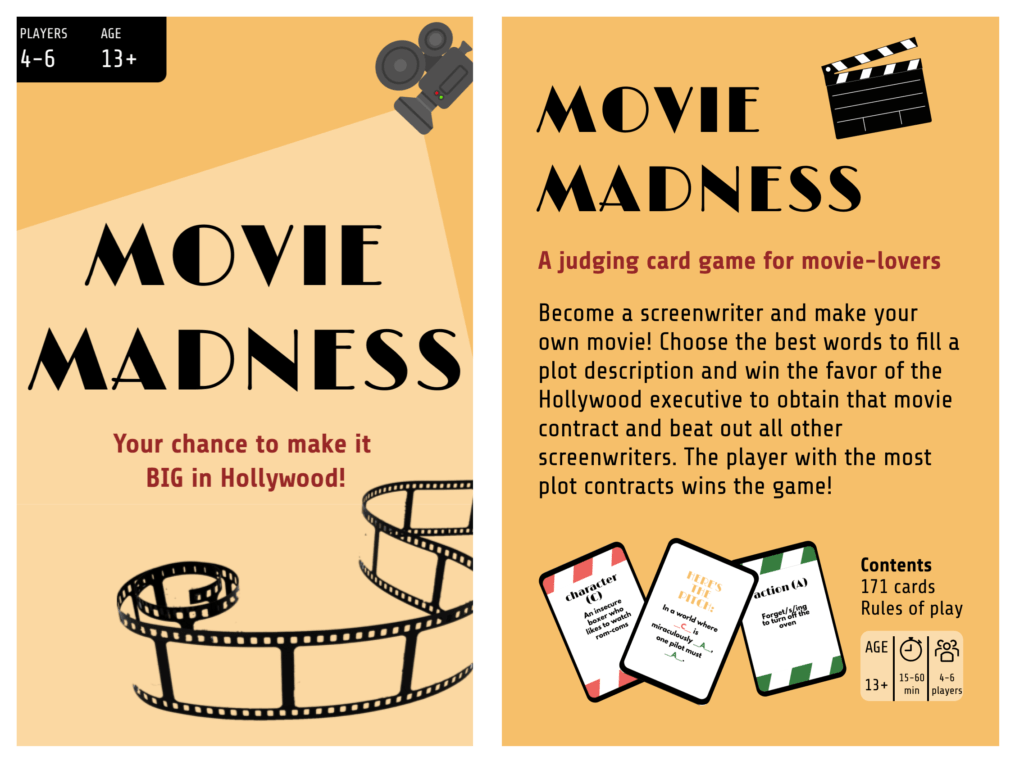
In our box design’s second iteration, we updated the images of the character and action cards to the latest version. We only have 2 iterations of our game box design due to time constraints, but if we were to continue developing this game, we would revise the phrasing of the description to make it more accurate, concise, and playful. We would also like to iterate on the art on the box, perhaps adding some images of multiple players enjoying the game together, to emphasize our core fun types of expression and fellowship.
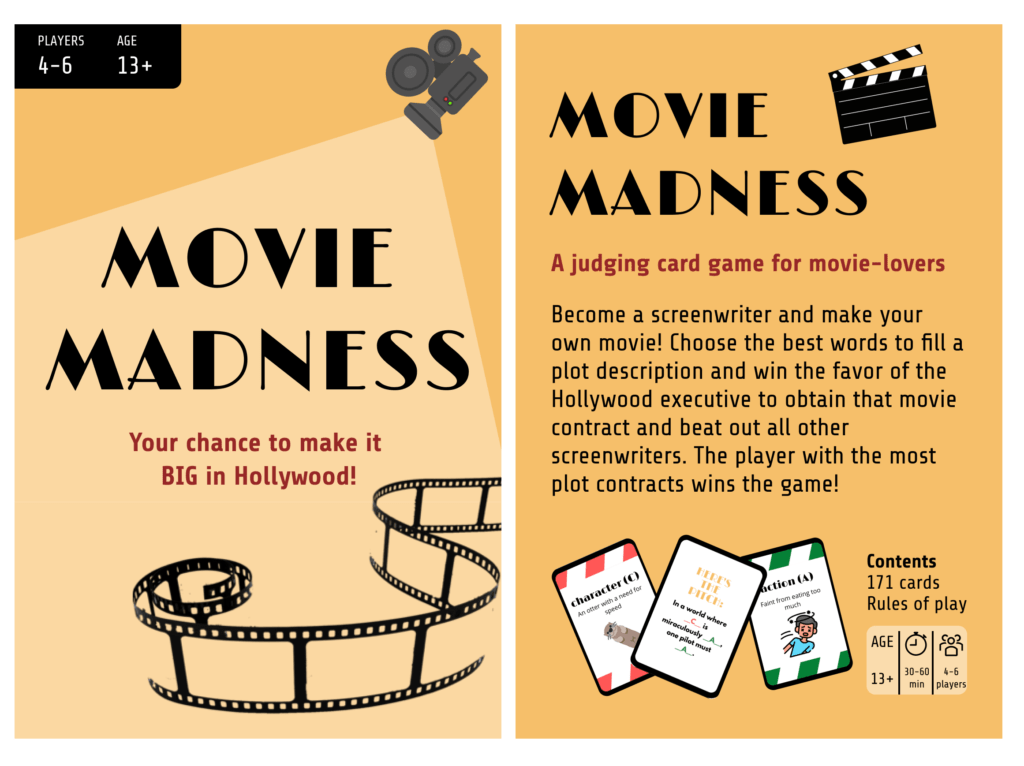
Accessibility
In our design, we made sure to add multiple forms of coding to our cards in order to accommodate folks with low vision or color blindness. Our cards are color coded as follows: plots are yellow, character cards are red, and actions are green. In addition, we wrote the labels on each card and included icons (a yellow movie clapper, a red character guy, and a green action bubble). On our character and action cards, we included graphics along with the character description or action that added extra information in case a player was unsure of the meaning of a card. All of these design choices were made with the goal of making sure our game is accessible to all players.
Final rules
- There is a given “fill-in-the-blank” movie plot card with blank spaces. Elect someone to be the Hollywood executive. This role will rotate each round clockwise. The players in each round who are not the Hollywood executive are called the screenwriters.
- There will be a pile of plot cards facing down, a pile of character cards facing down, and a pile of action cards facing down. Shuffle each deck separately. Deal out 4 character cards to each player and 4 action cards to each player. To start the game, draw a plot card and turn it over so everyone can see.
- Each screenwriter in a round fills in the blanks in the plot card by choosing, in their opinion, the best combination of character and action cards to fit the plot card. This combination is laid face down to indicate that a player is done choosing.
- If a player does not like some of the character or action cards they have in their hand, they may switch out a maximum of 2 cards (2 character cards, 2 action cards, or 1 of each) per round. However, if a player switches out cards in a round, they may not construct and pitch a plot for that round.
- After all screenwriters are done constructing their plots, their chosen cards can be flipped over and each created plot can now be read out loud by the Hollywood exec.
- The Hollywood exec then chooses the best plot in their opinion. The screenwriter who created the plot chosen by the Hollywood exec then is rewarded the plot card and thus the movie contract for that movie. Discard the used character and action cards in a separate pile.
- In each round, screenwriters re-draw character and action cards so they have the same number (4 of each) in their hands each round.
- The screenwriter who gets the most number of plot cards at the end of the game wins.
Final prototype
Print & Play
Download the print & play version with directions to play!
Appendix
Movie Madness Cards v0 (Used in playtest #1)
Movie Madness Cards v1 (Used in playtest #2)
Movie Madness Cards v2 (Used in playtest #3)


